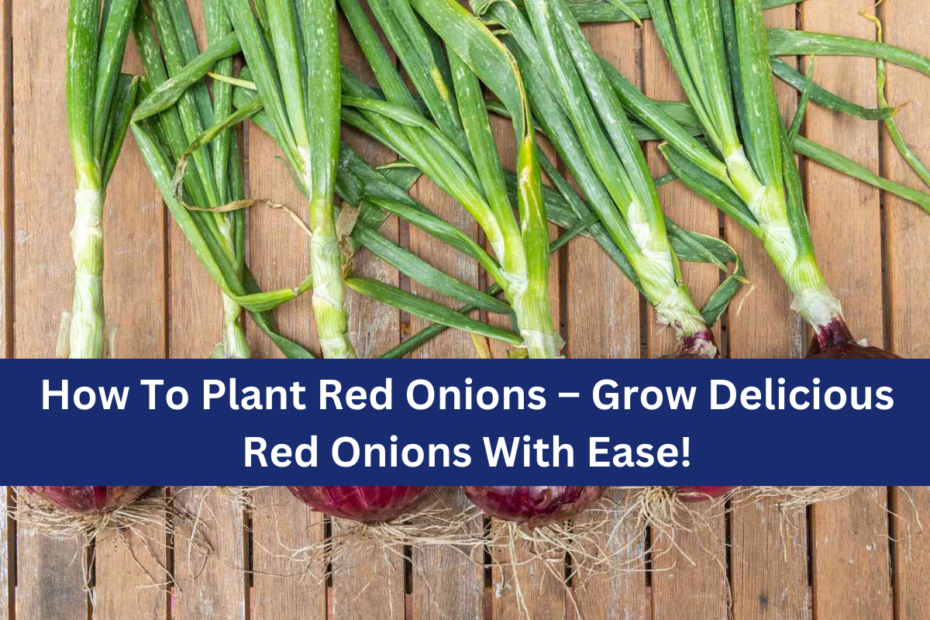How To Plant Red Onions – Grow Delicious Red Onions With Ease!: Onions of the red variety are a beautiful and savory addition to any garden, having both aesthetic value and culinary appeal.
There are a few essential procedures that need to be taken in order to successfully cultivate red onions. To make the process of planting and cultivating red onions as simple as possible, below is a thorough guide:
1. Choose the Right Variety
Choose a variety of red onion that is appropriate for the environment and growing season in your area. Some of the most well-known kinds are referred to as “Red Baron,” “Walla Walla,” and “Red Creole.” Your choice should be dependent on the climate of your area as well as the duration of your growth season.
2. Prepare the Soil
Onions do best on soil that is loamy, has good drainage, and has a pH that ranges from 6.0 to 7.0. You can improve the quality of the soil by adding compost or manure that has been well-rotted.
This will increase the fertility of the soil and improve drainage. Avoid planting bulbs in strong clay soils, as this might cause bulb rot.
3. Planting at the Appropriate Moment
The planting of red onions normally takes place in the early spring or fall, depending on the temperature of the area.
In areas with a lower average temperature, it is recommended to start seeds indoors eight to ten weeks before the date of the last frost, or to immediately sow seeds or sets outside as soon as the soil becomes workable.
4. Planting Depth and Spacing
When planting from seeds, it is recommended to place them at a depth of ¼ inch in seed trays or directly in the garden. One inch should be the distance between each seed or seedling.
Plant onion sets, which are sets of little bulbs, at a depth of one to two inches and space them four to six inches apart in rows. You should make sure that the tips of the sets are just below the surface of the soil.
5. Watering and Fertilization
Keep the soil moist at all times, but avoid letting it become soggy. Regular irrigation is essential for onions, particularly during periods of drought. A balanced fertilizer or one that is heavy in phosphate and potassium should be applied once the plants have established themselves.
The application rate should be determined according to the recommendations provided on the package.
6. Weeding and Mulching
When it comes to nutrients and water, onions might be a competitor for weeds. To prevent the onion roots from being disturbed, weeds should be removed on a regular basis using either a hoe or a hand hoe.
A layer of mulch, such as grass clippings or straw, should be applied to the soil in order to hinder the growth of weeds and assist retain moisture.
7. Monitor for Pests and Diseases
Be on the lookout for typical onion pests such as onion flies and thrips, as well as diseases such as downy mildew and neck rot. For the purpose of preventing the spread of diseases, it is important to practice proper garden hygiene and make use of the right organic or chemical remedies, if necessary.
8. Harvesting and Storage
Once the tips of the red onions begin to turn yellow and fall over, the onions are ready to be harvested. Use a garden fork or a hand trowel to carefully pull the bulbs off the ground. After the onions have been harvested .
They should be allowed to cure in a warm and dry environment for one to two weeks, until the skins become papery and the necks are completely dry. It is important to keep cured onions in a cool, dry location that has adequate air circulation.
Conclusion
You can ensure a good harvest of tasty red onions by following these methods. These onions may offer a splash of color and flavor to your meals, and they can be harvested successfully.
Whether you are an experienced gardener or just beginning your gardening journey, cultivating red onions is an undertaking that is both gratifying and pleasurable.
